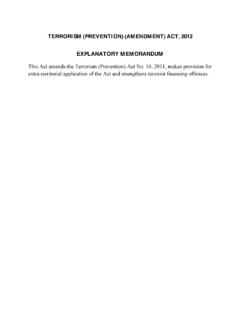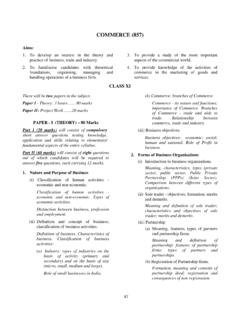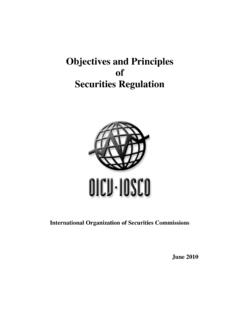Transcription of A User’s Guide to The Volcker Rule - Home | IFLR.com
1 A User s Guide to The Volcker Rule February 2014 2014 Morrison & Foerster LLP | All Rights Reserved | | Last updated Feb. 18, 2014 2 Table of Contents Summary ..3 SUBPART B Proprietary Trading ..5 SUBPART C Covered Funds Activities and Investments ..11 SUBPART D Compliance Programs ..24 APPENDIX A Reporting and Recordkeeping Requirements for Covered Trading Activities ..25 APPENDIX B Enhanced Minimum Standards for Compliance 3 Summary The legislation known as the Volcker Rule was enacted as part of the Dodd-Frank Wall Street Reform and Consumer Protection Act and codified in Section 13 of the Bank Holding Company Act of 1956, as amended ( BHC Act ).1 The Volcker Rule generally prohibits, subject to exceptions, a banking entity from engaging in proprietary trading and from acquiring or retaining an ownership interest in or sponsoring a hedge fund or private equity fund. Certain trading and fund activity is expressly permitted notably, underwriting activities, market making-related activities, and risk-mitigating hedging activities.
2 The Volcker Rule legislation covered the area with a broad brush, leaving many significant issues open to regulatory interpretation. In December 2013, five federal financial regulatory agencies (collectively, the Agencies ),2 adopted a final rule (the Final Rule ) construing the Volcker The Final Rule also sets out a compliance and reporting regime for banking entities engaged in proprietary trading or fund sponsorship or investment. The determinations made by the Agencies in the Final Rule reflect two years of comment and debate following the issuance of a Proposed Rule (the Proposed Rule ) in November 2011. Under the Final Rule, larger banks and bank affiliates (based on total assets) that are engaged in proprietary trading permitted by the Final Rule will be subject to a compliance regime to ensure compliance with the Final Rule. In addition, larger banks and bank affiliates (in terms of the amount of their trading assets and liabilities) that are engaged in proprietary trading permitted by the Final Rule will be required to report a highly technical set of quantitative measures.
3 Banking entities with only a modest level of trading and fund investment activities will be subject to a much less comprehensive set of compliance requirements. The compliance requirements are discussed in more detail below. The Final Rule is complex in scope and has already elicited significant commentary and questions from the banking industry and the public at large. The purpose of this Guide is to discuss the requirements of the Final Rule at a practical level. While the relevant components of the Final Rule are addressed here, financial institutions should consider all of the Final Rule s fine print the many detailed definitions and conditions that comprise the Final Rule (as well as the extensive commentary 1 Section 619 of the Dodd-Frank Wall Street Reform and Consumer Protection Act, Pub. L. No. 111-203, 124 (July 21, 2010) ( Dodd-Frank or the Act ); Section 13 of the Bank Holding Company Act ( BHC Act ), 12 1851.)
4 2 The Federal Deposit Insurance Corporation ( FDIC ), the Federal Reserve Board ( FRB ), the Office of the Comptroller of the Currency ( OCC ), the Securities and Exchange Commission ( SEC ), and the Commodity Futures Trading Commission ( CFTC ). 3 The Final Rule may be found at The Final Rule was accompanied by a long explanatory commentary ( Attachment B ). Attachment B may be found at 4 contained in Attachment B to the Final Rule) before making any decisions regarding compliance. The Volcker Rule, as construed by the Final Rule, has special application to foreign banking organizations that have bank subsidiaries or operate branches, agencies or commercial lending company subsidiaries in the United States ( FBOs ). Please refer to our Client Alert dated December 12, 2013 for a more complete explanation of the impact of the Final Rule on FBOs. The Client Alert may be found at The Conformance Period The Final Rule is effective April 1, 2014, but the compliance period during which banking entities must conform their activities to the Volcker Rule has been extended for one year until July 21, 2015.
5 Nonetheless, effective June 30, 2014, the largest banking entities (those with $50 billion or more in consolidated trading assets and liabilities, as discussed further below) are required to report quantitative measurements to regulators. The FRB emphasized in its order approving the extension of the conformance period that each banking entity is expected to engage in good-faith efforts, appropriate for its activities and investments, that will result in conformance with the Volcker Rule not later than the end of the conformance period. Moreover, banking entities should not expand activities or make investments during the conformance period with an expectation that additional time to conform those activities or investments will be granted, and banking entities with stand-alone proprietary trading operations are expected to promptly terminate or divest such operations. Banking Entities The Volcker Rule applies to banking entities. A banking entity includes: (i) any insured depository institution; (ii) any company that controls an insured depository institution (in other words, any bank holding company or savings and loan holding company); (iii) any FBO; and (iv) any affiliate of the foregoing.
6 The term affiliate is used as defined in the BHC Act and thus includes any company controlled by a banking entity. Notwithstanding the breadth of the definition of a banking entity, there are certain specific exceptions. For example, a banking entity does not include a covered fund that is not itself a bank holding company or an FBO. This is an important exception. A bank holding company that serves as the general partner of a fund would be deemed to control that fund. But for this exception, the covered fund would itself be a banking entity subject to the Volcker Rule. 5 In addition, a banking entity does not include a portfolio company held by a bank holding company or an FBO under the so-called BHC Act s merchant banking authority,4 a company controlled by an insurance company affiliate of a bank holding company,5 or any portfolio concern that is controlled by a small business investment company, as defined in Section 103(3) of the Small Business Investment Act of 1958, as long as the portfolio company or portfolio concern is not itself an insured depository institution, a bank holding company or savings and loan holding company, or an FBO.
7 SUBPART B6 Proprietary Trading The Volcker Rule prohibits a banking entity from engaging in proprietary trading, subject to certain exceptions discussed below. Proprietary trading is defined as engaging as principal for the trading account of the banking entity in the purchase or sale of a financial instrument. Thus, compliance with the Rule by a banking entity depends on whether the account for which the trade is placed satisfies the definition of trading account and whether the trade involves a financial instrument. Definitions Trading Account. The Final Rule provides a functional definition of trading account, which means an account that satisfies any one of three criteria: a purpose test, a market risk capital rule test, or a status test. The Purpose Test. A trading account includes any account used by a banking entity to buy or sell a financial instrument principally for the purpose of short-term resale, benefitting from actual or expected short-term price movements, realizing short-term arbitrage profits, or hedging a position resulting from any of the foregoing trading activities.
8 Market Risk Capital Rule Test. If the banking entity or any affiliate is an insured depository institution, bank holding company, or savings and loan holding company and calculates risk-based capital ratios under the market risk capital rule, a trading account includes accounts used to buy or sell one or more financial instruments that are both market risk capital rule covered positions and trading positions (or hedges of other market risk capital rule covered positions). Status Test. If the banking entity is licensed or registered (or required to be licensed or registered) to engage in the business of a securities dealer, swap dealer or security-based swap dealer, a trading account includes any account used by a banking entity to purchase or sell financial instruments for any purpose to the extent the financial instruments are purchased or sold in connection with activities that require the banking entity to be so licensed or registered. 4 12 1843(k)(4)(H).
9 5 12 1843(k)(4)(I). 6 The Volcker Rule is 71 pages long and consists of Subparts A through D and Appendices A and B. Subpart A is titled Authority and Definitions, and is not discussed directly here. 6 Trades are presumed to be for the trading account of a banking entity if the banking entity holds the position for fewer than sixty days, unless the banking entity can demonstrate that it did not make the trade for any of the purposes described in the preceding paragraph. As the definition of a trading account is broad, the Rule excludes the following types of trading from the definition of proprietary trading: Trades pursuant to purchase or reverse repurchase agreements; Trades that arise under a transaction in which the banking entity lends or borrows securities temporarily under an agreement pursuant to which the lender retains the economic interest in the securities, and has the right to recall the loaned securities; Trades for the purpose of liquidity management in accordance with a documented liquidity management plan that meets specific requirements of the Final Rule;7 Trades by a derivatives clearing organization or clearing agency in connection with clearing or settlement of financial instruments; Any excluded clearing activities 8 by a banking entity that is a member of a clearing agency, a member of a derivatives clearing organization or a member of a designated financial market utility.
10 Trades to satisfy an existing delivery obligation, including to prevent or close out a failure to deliver, in connection with delivery, clearing or settlement activity; Trades to satisfy an obligation in connection with a judicial, administrative or self-regulatory organization or arbitration proceeding; Trades where the banking entity is acting solely as agent, broker or custodian; Trades through a deferred compensation, stock-bonus, profit-sharing or pension plan of the banking entity; and Trades made in the ordinary course of collecting a debt previously contracted ( DPC ) in good faith, provided that the banking entity divests the financial instrument as soon as practicable. 7 The liquidity management plan should: (i) specifically contemplate and authorize the particular securities to be used for liquidity management purposes, the amount, types, and risks of these securities that are consistent with liquidity management, and the circumstances in which the securities may be used; (ii) require that any transaction in securities under the plan be principally for the purpose of liquidity management and not for short-term price movements, resale, profits or arbitrage; (iii) require that any securities purchased or sold for liquidity management purposes be highly liquid and limited to securities the risks of which the banking entity does not reasonably expect to give rise to appreciable profits or losses in the short term; (iv) limit any securities and other instruments purchased or sold for liquidity management purposes to an amount consistent with the banking entity s near-term funding needs.













